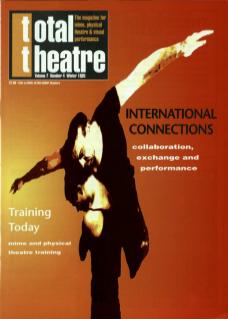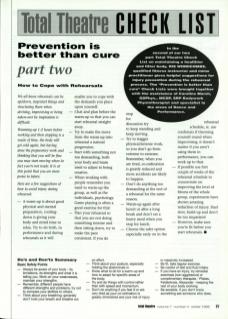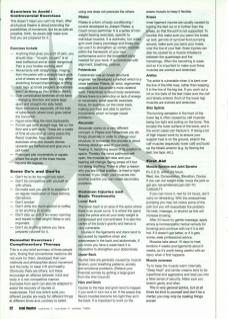How to Cope with Rehearsals
We all know rehearsals can be up/down, stop/start things and structuring them when devising, improvising or being taken-over by inspiration is difficult. Warming-up 1-2 hours before working and then stopping is a waste of time, the body will get cold again, but having done the preparatory work and thinking that you will be fine you may start moving when in fact you're not ready. It is at this point that you are more prone to injury. Here are a few suggestions of how to avoid injury during rehearsal:
- A warm-up is about good physical and mental preparation, cooling-down is giving your body and mind time to relax. Try to do both, in performance and during rehearsals as it will enable you to cope with the demands you place upon yourself.
- Chat and plan before the warm-up so that you can start rehearsal straight away.
- Try to make the move from the warm-up into rehearsal a natural progression.
- Start with something not too demanding, both your body and brain need to adjust to being creative.
- When working with people remember you need to warm-up the group, as well as the individuals, psychology. Game playing is often a good exercise for this!
- Plan your rehearsal so that you are not doing something intense and then sitting down, try to make the pace consistent. If you do stop for discussion try to keep standing and keep moving.
- Try to stagger physical/intense work, so you don't go from extreme to extreme.
- Remember, when you are tired, coordination is greatly reduced and more accidents are likely to happen.
- Don't do anything too demanding at the end of a rehearsal for the same reason.
- Warm-up again after lunch or after a long break and don't eat a heavy meal when you stop for lunch.
- Choose the safer option especially early on in the rehearsal schedule, i.e., use crashmats if throwing yourself around when improvising, it doesn't matter if you aren't using them in performance, you can work up to that.
- If possible use first couple of weeks of the rehearsal schedule to concentrate on improving the level of fitness of the whole group, experiments have shown amazing reduction of injury. Start slow, build-up and don't be too impatient!
- However, make sure you're fit before you start rehearsals.
Dos and Don'ts Summary
Basic Safety Points
- Always be aware of your body – its limitations, its strengths and what it is telling you. Work on your weaknesses, maintain your strengths.
- Remember, different people have different strengths and problems, try not to compare your abilities to others.
- Think about your breathing: generally don't hold your breath and breathe out on effort.
- Think about your posture, especially holding the abdominals in
- Know what to do for a warm-up and how to adapt for specific areas of the body.
- Try and do things with control rather than with speed and momentum.
- Don't do anything if you feel ill or are very tired as your coordination is greatly diminished and your risk of injury is massively increased.
- Be fit, take regular exercise.
- Be careful of diet and fluid intake.
- If you have an injury, try remedial exercises (non-aggressive) or complimentary therapies – Pilates, Feldenkrais, Alexander – keeping the rest of your body working.
- Be sensible. If you don't know something ask someone who does.
Exercises to Avoid / Controversial Exercises
This doesn't mean you can't do them. After all physical theatre is about extending the possibilities of movement, but be as safe as possible, think, be aware and make sure that you are prepared for it.
Exercises Include
- Anything that gives you a lot of pain, you should stop – ‘no pain, no gain’ is at best ineffectual and at worst dangerous. Pain is your body’s warning alert!
- Movements with straight legs, hinging from the pelvis with a straight back puts a lot of stress on lower back – e.g. either stretching forward (hamstrings) or lifting both legs up (most people's abdominals aren't as strong as they'd like to think!).
- Over complicated stretches of the back – changing direction and plane (legs apart and straight into side twist). Back extensions especially off the side of table/bench where torso goes below the horizontal.
- Hyper-extending the neck backwards.
- Full sit-ups (with straight legs, flat on the floor and a stiff back). These are a waste of time as you end up using psaos (hip flexor) muscles. Also, abdominal exercises when the muscle domes upwards are ineffectual and give you a pot-belly!
- Prolonged plie movements or squats where the angle of the knee moves beyond 90 degrees
Some Dos and Don'ts
- Don't try to do too much too soon.
- Don't be competitive with yourself or with others. Do make sure you are fit to exercise if on regular medication or have asthma.
- Get advice.
- Don't smoke!
- Don't drink too much alcohol or coffee, or do anything to excess.
- Don't stay up until 3am every morning and expect to feel alright! Sleep is very important.
- Don't do anything before you have prepared yourself for it.
Remedial Exercises / Complimentary Therapy
This is a very brief summary of three people who, finding that conventional medicine did not work for them, developed their own methods and philosophies about movement and the body, to keep it fit and healthy. Obviously there are others, but these encourage an alliance between mind and body in a non-competitive manner. Exercises from each can also be adapted to assist the recovery of injuries or weaknesses. Find one which suits you, different people are ready for different things at different times and, contrary to belief, using one does not preclude the others.
Pilates:
Pilates is a form of body conditioning / control developed by Joseph Pilates, a Czech circus performer. It is a series of non-weight-bearing exercises, specific to individual muscles. It is isokinetic, but unlike gym work (heavy poundage and linear) you can use it to strengthen up certain muscles within the framework of your own performance and in the movement style needed for your work. It is concerned with alignment, breathing, posture.
Feldenkrais:
Feldenkrais was an Israeli structural engineer. He developed a method which is a cross between Pilates, i.e. strict, regimented exercises and Alexander's more cerebral work. Feldenkrais is about body awareness. Where there is a restriction or lack of energy or movement, small specific exercises focus, for example, on the lower back, making you freer and able to perform movements which no longer cause problems.
Alexander
Alexander works on a very different concept. In Pilates and Feldenkrais you do things physically in order to change your structure. In Alexander the process is about thinking about an area of your body, 'freeing' it, becoming aware of its position in space. Thereby the nerve pathways will open, the muscles will relax and your bearing will change. Being aware of it but not doing anything. There is often a reason why you are in that position, i.e. tired or tight muscles. If you 'push' your muscles into another position you can create secondary problems.
Common Injuries and Basic Treatments
Lower Back
The lower back is an area of the spine where there is an acute curve. It is where the spine joins the pelvis and all your body weight is compressed and concentrated. It is also the centre of the body's gravity and hence is very vulnerable. Injuries in the ligaments and discs tend to be caused by repetitive strain and weaknesses in the back and abdominals. If you know you have a weak back it is imperative to strengthen your abdominals.
Upper Back Injuries here are generally caused by muscle tension, poor breathing patterns, anxiety and emotional problems. (Relieve your financial worries by getting a large grant from the Arts Council!)
Hips and Groin
Injuries to the hips and groin tend to happen if you work in turn-out a lot. If the psaos (hip flexor) muscles become too tight they arch the back. It is important to work on the psaos muscle to keep it flexible.
Knees
Inner ligament injuries are usually caused by turning the feet out or in further than the knees, so that the joint is not supported. To counter this make sure you warm the knees up well, get lots of synovial fluid pumping around, make sure you bend your knees over the line of your feet. Knee injuries can also be caused by a muscle imbalance between the quadriceps and the hamstrings. Often the hamstring is weak, and so it is important to make sure these muscles are worked and stretched.
Ankles
The ankle is vulnerable when it is bent over the line of the little toes, rather than keeping it in the line of the big toe. If you work out a lot on the balls of the feet make sure the calf and tibialis anterior (front of the lower leg) muscles are worked and stretched.
Shin Splints
The burning sensation in the front of the lower leg is often caused by calf muscles being too tight and pulling on the bone. This bruises the outer surface of the bone, and in the worst cases can fracture it. If doing a lot of high impact work try to ensure your support heel is on the ground, stretch the calf muscles (especially lower calf) and build up the tibialis anterior (e.g. by flexing the feet, toe taps, etc).
First Aid
Muscle Sprains and Joint Sprains
R.I.C.E.D. within 24 hours. Rest, Ice, Compression, Elevation, Doctor. If you cannot weight-bear, move the joint, or get any nerve/referred pain GO TO CASUALTY.
If you can move it, rest for 24 hours, don't carry on rehearsing. With the endorphins pumping you may not notice some of the pain but you will exacerbate the problem. No heat, massage, or alcohol as this will increase bruising.
After 24 hours try gentle massage, apply arnica (a homoeopathic herbal remedy for bruising) and continue with ice if it is still hot. If it doesn't get better, or if it gets worse, seek professional advice.
Muscles take about ten days to heal, tendons four weeks and ligaments about six weeks, so it's worth being careful with an injury when it first happens.
Muscle soreness
Try to keep the muscle warm internally. Deep Heat and similar creams tend to be superficial and aggressive and lead you into a false sense of security. Make sure you stretch gently and often.
This is very general advice, but at all times be kind to yourself and don't be a martyr, you may only be making things worse!


